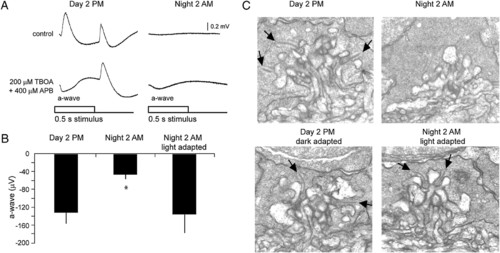- Title
-
Zebrafish larvae lose vision at night
- Authors
- Emran, F., Rihel, J., Adolph, A.R., and Dowling, J.E.
- Source
- Full text @ Proc. Natl. Acad. Sci. USA
|
Photoreceptor function is altered at night. (A) ERG recordings from eyes of fish incubated in fish water (control) and in fish water containing a drug mixture to block the b-wave. The a-wave, reflecting photoreceptor outer segment hyperpolarization and revealed after drug treatment, was significantly smaller at night (2 AM) than during the day (2:00 PM). (B) Averaged a-wave amplitudes (n = 15) taken from drug-treated fish at a 12-h interval (2:00 PM and 2:00 AM); and from fish that were exposed to light for 3 h at night. A-wave amplitudes at 2 AM were reduced by about 65% from those measured at 2:00 PM. Three hours of light adaptation at night increased a-wave amplitudes to control level (*, P < 0.01 and bars indicate SD). (C) EM sections of cone pedicles at different times of the day and under different exposures to light. Most cone pedicles exhibit prominent synaptic ribbons during the day (2:00 PM), but are essentially devoid of synaptic ribbons at night (2:00 AM). When fish are exposed to darkness for 3 h during the day (dark-adapted 2:00 PM) synaptic ribbons are still observed. Exposure to 3-h day light conditions at night (light-adapted 2:00 AM) prevents the degradation of synaptic ribbons that usually occurs at night and synaptic ribbons are observed. Arrows denote synaptic ribbons. |

